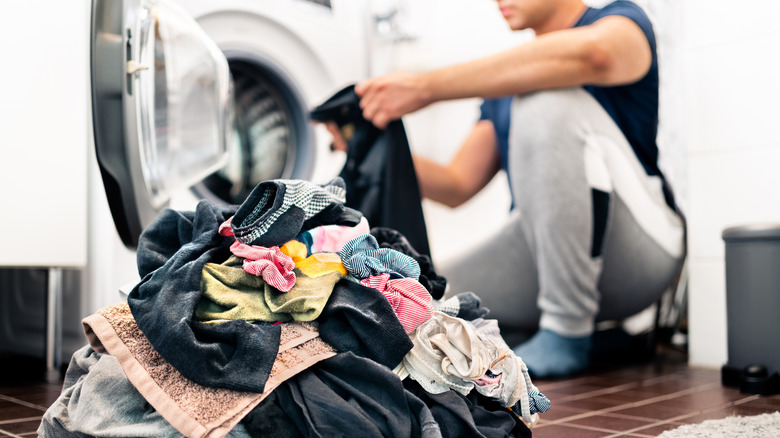The Extra Laundry Step To Take In Fall That Helps Eliminate Allergens
Spring always gets a bad rap among the seasons for causing the most allergic reactions, but the arrival of colder months in the fall hides a few menacing sources for allergens as well. Poor ventilation as a result of trying to keep the cold out, dusty indoor heating systems getting turned on for the first time in months, more human activity indoors, and warm or humid homes creating the perfect breeding ground for mites and mold all contribute to this phenomenon. With allergens making themselves at home in the textiles around the home, experts recommend more frequent and intense laundry habits for the season.
One extra step you can take to deep clean your sheets, blankets, towels, and clothes is laundry stripping. The viral laundry hack, which gained quite the following during the Covid-19 pandemic, consists of soaking "clean" laundry in hot water, with a mix of borax, washing soda, and detergent, for about four hours, stirring occasionally.
For a standard tub, use ¼ cup borax and ¼ cup washing soda for ½ cup of detergent. After, drain the dirty water, rinse the laundry in the washing machine, and dry as you normally would. The temperature of the water will help kill dust mites, while the cocktail of cleaning products will undo the damage created by faulty laundry habits, so you can always get fresh, allergen-free laundry in the future.
The role laundry stripping plays in eliminating allergens
Understanding laundry stripping and its effect on clothes is crucial to deciding whether you should be including it in your routine over the fall. The direct goal of this process is to strip your laundry of all the built-up detergent, fabric softener, and hard water. The excessive use of the former two products negatively affects your textiles, especially those with thick fibers like towels, by starting a vicious cycle that keeps them from ever getting truly cleaned.
If not properly rinsed, these substances will stick to your clothes, creating thin coats that trap dirt, grime, odors, and allergens, and block proper water absorption in future wash cycles. In turn, the minerals in hard water also leave residue and affect detergent performance, which only makes the situation worse. By stripping your laundry, you're essentially giving it a fresh start. This process, however, is quite harsh on fibers, possibly damaging and shrinking them, so it should not be used on delicate fabrics or become a regular occurrence in general.
Instead, if your clothes feel stiff, sticky, don't smell fresh even when you've just washed them, look dull, or simply need a deeper clean during fall, given the challenges of cold and humid weather, strip-wash them once. Then, reduce the amount of detergent per wash cycle, consider skipping the fabric softener altogether, and leave enough room in the machine drum for proper agitation and water distribution. You should also test water hardness and adjust your detergent accordingly. In critical cases, a water softening system may be the answer.

